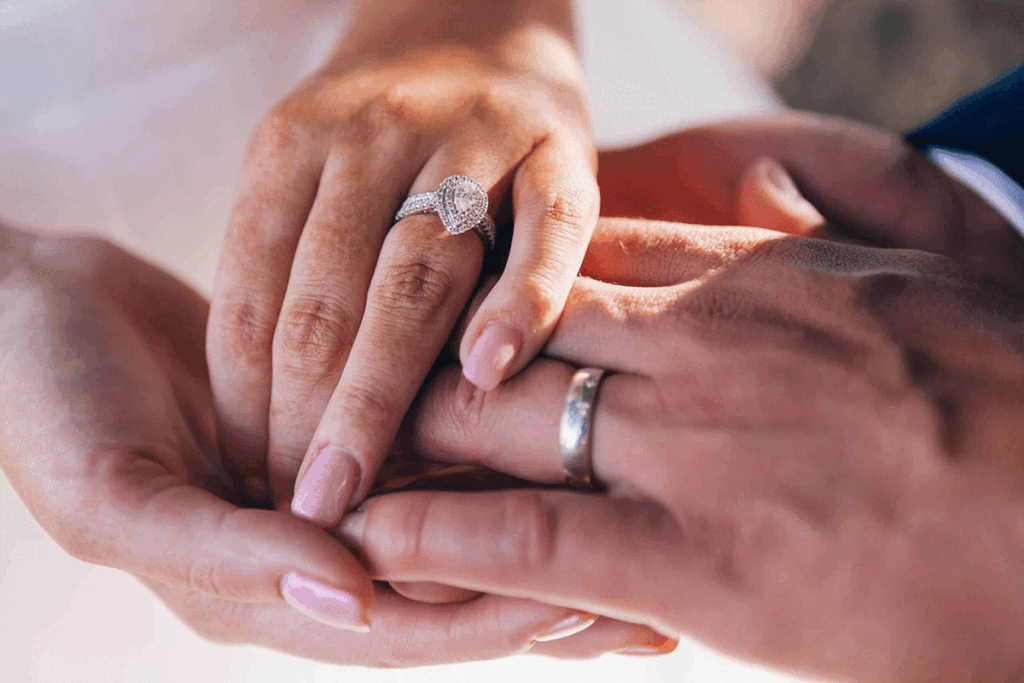How thick or thin should engagement rings be? This question is very far from people’s minds when they shop for such an item. They would be so preoccupied with the design, color, metal, with or without stones, price, etc.
Yet that question, as irrelevant it may seem, could mean a lot in terms of comfort and its overall appearance when worn around a woman’s finger.
How Thick or Thin Should Engagement Rings Be?
Here we seek to answer that question and much more. We’ll provide a brief history of engagement rings, the types of settings and how each should be worn and by whom. Hopefully, at the end of this reading, you’ll be better equipped when shopping around for one.
But before going any further, here’s a little throwback about engagement rings worth reading.
Engagement Rings – Then and Now
An engagement ring is a sign of commitment to marriage. When a guy slips a ring on the finger of the girl of his affection, they are considered engaged to be married.
But that wasn’t the case in ancient Rome where the practice originated. Back then, an engagement was a symbol of a business contract or an affirmation of mutual love and obedience. Not very romantic, was it? And they were a far cry from modern-day engagement rings. They were nothing then but rings made from simple indigenous materials like ivory, flint, bone, copper, and iron. The earliest proof that some engagement rings were made of gold was found in the ruins of Pompeii.
At any rate, in 850 A.D., Pope Nicholas I decreed that engagement rings are symbols of a man’s intent to marry the woman he loves. And where possible, it must be made of gold. Unwittingly, this ushered in the primary use of gold rings until today.
How Diamond Entered the Picture
In 1477, Archduke Maximillian gave Mary of Burgundy an engagement ring laced with a long strip of small diamonds mounted in the shape of the letter “M.” But that did not put the gem into prominence in the engagement ring niche. That happened in 1947 when the De Beers mining company promoted the diamond purely for business reasons. He did this through his “A diamond is forever” advertising campaign. It worked. Since then diamonds have become the staple for fine jewelry and engagement rings.
However, not all good things last forever. Though diamonds have not entirely lost their allure and demand, millennials are not so keen about it.
Millennials want to walk a path different from that taken by their elders. They prefer colored stones over diamonds as engagement ring stones and steer away from gold in favor of less conventional materials like meteorite, platinum (like the one in this Mappin and Webb review, or titanium. How thick or thin doesn’t matter. What they care more about is to “make a statement,” to be unique and different. “Individualism” is their mantra.
Types of Engagement Rings
“If I know what love is, it is because of you,” Herman Hess.
And in the subject of “love,” the engagement ring is its monumental expression. And for this reason, engagement rings are the highest-selling item in the ring niche.
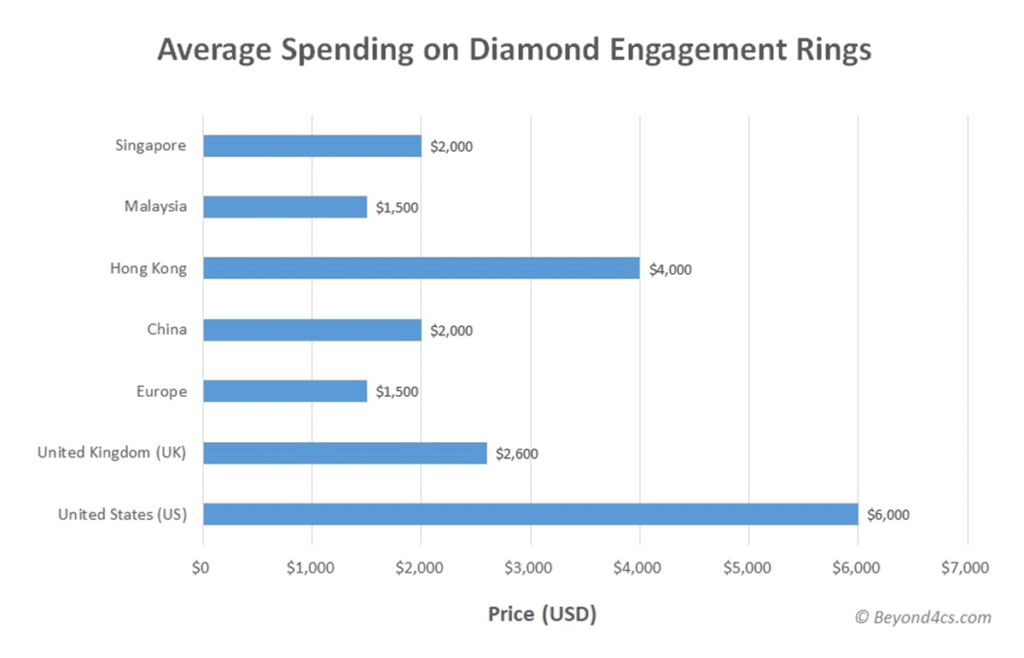
So before dwelling on what band thickness is, it is best for you to be familiar with the different types of engagement rings in the market. There are more than a dozen types, but the most popular are:
Plain and simple
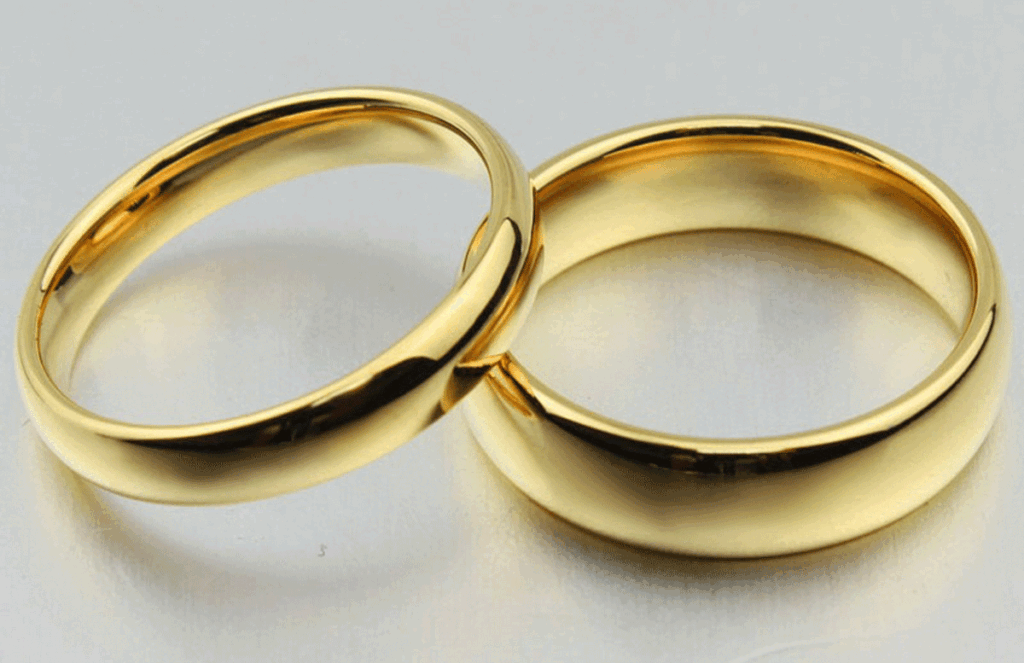
This type of ring has no center stone. It may be embellished by floral carvings or any kind of pattern. Plain engagement rings put focus on what is important. But they can be elegant and timeless. The material can be any of the various shades of gold, sterling silver, or titanium.
Solitaire
It is called solitaire because of it being of single-stone design. To highlight its beauty, the solitaire diamond is best mounted on a simple band with a prong or claw setting.
It is good for people who go for simplicity, yet with a touch of elegance. If done well, it can stand the test of time; never going out of fashion.
Cluster
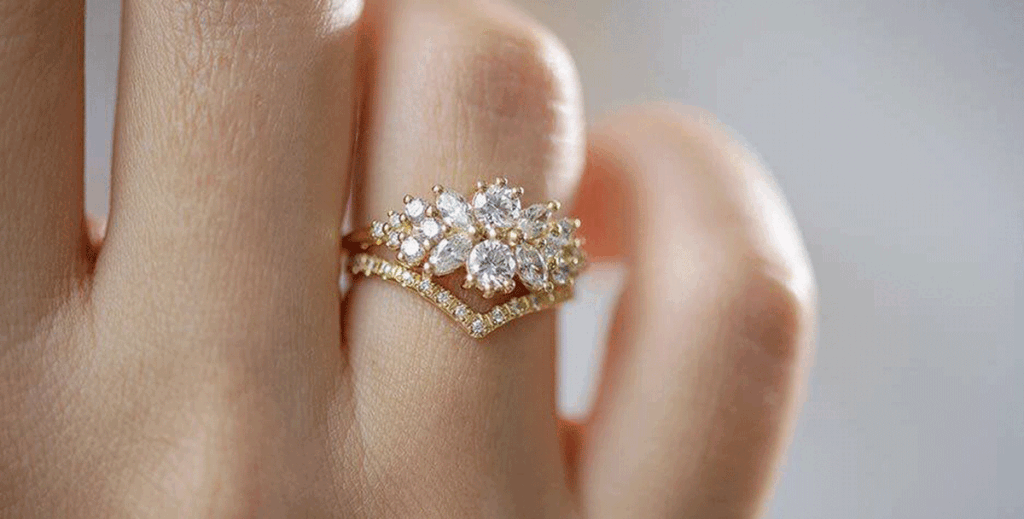
Pavé
Pave engagement rings have tiny diamonds embedded around the ring band. This arrangement makes the ring catch more light and makes it seem to glow on your finger.
An attractive twist to this is to mix colored stones with the diamond. It’s kind of personalizing it. Pave rings look dainty and feminine.
Cathedral
Cathedral engagement rings have been popular for decades because of their traditional, yet elegant style. It is so-called because of the way the shank and shoulder curve up (looking like a cathedral) to support the center stone.
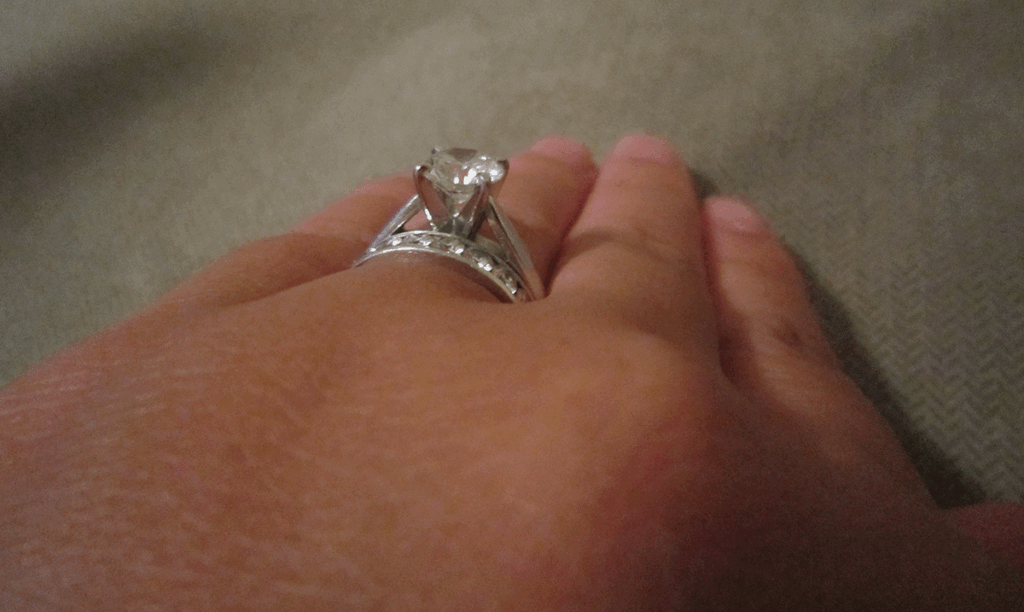
To add more flair (and cost) pave diamonds can be set along the sides to add more sparkle. In any case, the structure and its architecture make this engagement ring style an all-time favorite.
Halo
The halo is another type of popular engagement ring because of its shimmering dazzle that augments the sparkle of the center stone.
The halo engagement ring is distinguished by the number of smaller diamonds surrounding the large center stone. The reflection of the smaller stones into the larger stone makes it look more brilliant and sparkly.
Bezel Type
Bezel-type engagement rings offer the most secure stone setting. The gem is anchored in place with a metal border, instead of prongs. This setting type offers less risk of the stone being detached or falling out.
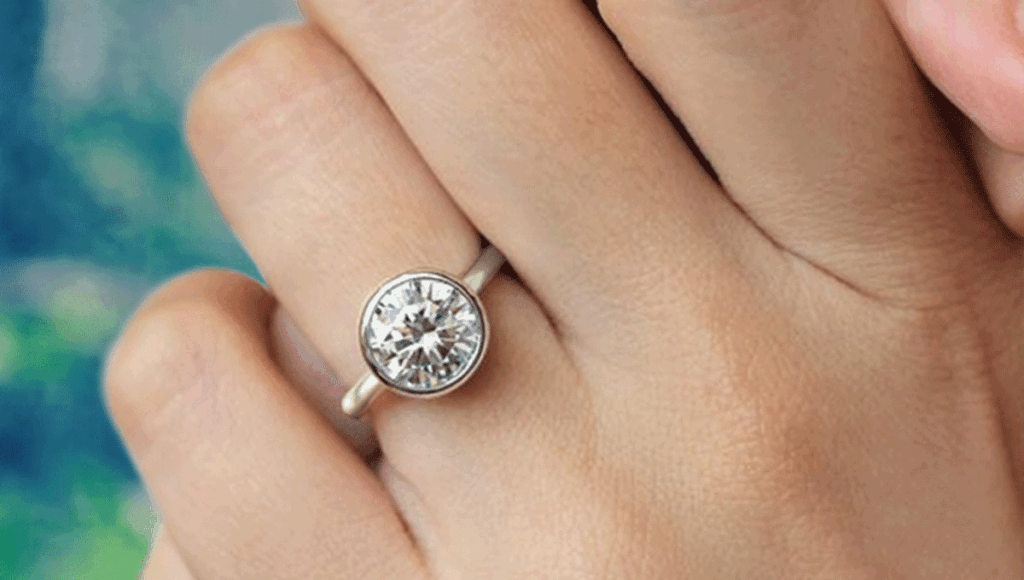
Bezel-type engagement rings don’t require much upkeep. The downside is a huge surface area of the stone is covered, diminishing its glitter and sparkle.
Are Engagement Rings Supposed to be Thin?
If this question sounds a little bit murky to you, what is referred to here is the band—the bottom portion of the ring that wraps around the ring finger. It is also called “shank” and is the part jewelers shave off to resize a ring.
With that sorted out, it will probably make more sense if the question is paraphrased to “how thick or thin should engagement rings be?”
There is no universal answer to the question because different users have different preferences. The suitability of a ring’s band is partly determined by the shape of the wearer’s hand or finger and her lifestyle.
Another thing before going any deeper into this article is to know that band thickness (or thinness) is a measure of a ring band’s width—not its cross-section. Hence, it is erroneous to compare ring thickness vs width because they are the same.
So here’s what a thin or thick band looks like and why they are important when shopping for an engagement ring:
Thin bands
Thin bands are very popular at present. They look feminine, elegant, and can make the center stone look larger. They range from 2 mm or less. But is a 2mm engagement band too thin? This is the upper threshold of thin bands. Jewelers don’t recommend anything less than 1.5mm.
Does a thin band make a diamond look bigger? Yes, if the center stone is set in thin prongs.
Thick bands
Thick bands range from 2.5 – 3mm. Some can go as high as 6mm. But they can be uncomfortable beyond that.
Modern and contemporary rings with more complex settings have thick bands. They allow more stones to complement the center stone; offer more room for more complex designs than thin bands.
Of course, thick bands are more durable and resistant to everyday wear. The downside is that they are more pricey and if not done well, may make the center stone look smaller.
What Thickness Should an Engagement Ring Be?
There are so many things to consider when buying an engagement ring. Though band thickness may be the last, it is an important factor that determines how the diamond center stone will look on your finger and the designs you want to be incorporated therein.
So here are important things to keep in mind:
- Ring band width is affected by current trends. It can go from thin and dainty, to wide and bold. So trend changes may affect your choice down the road.
- The ring material will also have a direct impact on width. Thin bands need strong materials like platinum or stainless steel, while thick bands can do well with gold or silver.
- Your partner’s hand and lifestyle also affect the ring’s width.
So here are a few details related to the above:
Thick or Thin Band: Factors to Consider
Average ring band width
The average engagement ring width is between 2 to 6 mm. In between widths of 3 and 4 mm are considered standard.
Stone size and shape
The center stone size and shape directly influence a ring’s width. While thin and dainty bands are trending right now widths below 3 mm will be difficult to support a stone bigger than one carat.
However, if you opt for a smaller stone, a thick band will make it look smaller, while a thin band will make it look bigger.
If you want a fancier stone shape, like a heart or emerald, a thinner band will make the stone look dazzling. But if you want to have side stones, then a 3 to 4 mm band will do a better job.
To have the best of both worlds, choose a ring between 3 to 4 mm band. This will give you the flexibility of stone size and shape. It’s considered not too small, not too big.
Choice of metal
Your choice of metal will also have an impact on your engagement ring band. Gold and silver are soft, so they are not suitable for thin bands. Besides, they wear out more quickly, bend or break.
Thinner bands should use stronger materials like platinum, or palladium.
Hand and finger size
A thick band will look chunky on a girl with small and thin hands. A thin band, say 2mm, will nicely complement her finger and hand size.
On the other hand, if she has large hands or thick fingers, thicker bands, 4 mm, will be more suitable.
Her lifestyle
Does she do a lot of manual work? Is she active and always on the go? If she is, then a stronger metal would be more suitable than the softer type.
Not only is her lifestyle important in deciding on an engagement ring’s thickness, but her personal preferences as well.
Is she the arty type? Does she want a band with detailed engraving work; or additional stones. If she does, a band 4 mm or wide will be apt for her personal preferences.
Does she like stacked rings? If she does, a thin band is more appropriate.
One of the most important considerations is your partner’s own personal style. If she is inclined towards a ring that makes a bold statement, then buy her a 6 mm ring.
Thin vs Thick Wedding Band
As seen from above, there is no straightforward answer to this.
A thin engagement ring band will make a smaller center stone look bigger. It can hold fancy-shaped diamonds or any solitaire setting. It complements a thin or small finger, and they look dainty and neat. In fact, they are trendy right now.
On the other hand, thick bands are more durable. They are appropriate for people who constantly use their hands. They can support larger stones, as well as other accent stones and other decorative work.
And they make a bold statement on the wearer’s finger.
“How thick or thin should engagement rings be” does not have a clear-cut answer. There are so many things to consider for a definite answer. Things like the type of stone, color, ring design, metal to be used, type of person it is given to, and her personal lifestyle all play crucial roles in choosing thick or thin bands. Then, of course, there is the price tag.
Now that you know more about choosing between thick and thin engagement rings, perhaps you want to know more about popular engagement rings, check out our article “15 Carats of Fame: Famous Engagement Rings in History.”
